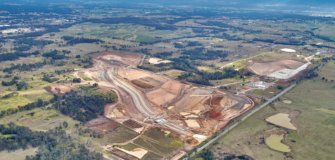Queensland’s Major Project Pipeline Surges Past $127 Billion
Martin Sinclair Nov 18

Queensland’s major project pipeline has reached record levels, with $127.5 billion in engineering construction planned over the next five years, according to the 2025 Queensland Major Projects Pipeline Report (QMPPR) released today by the Queensland Major Contractors Association (QMCA).
In its 14th edition, the report reveals a 22.7% increase in total pipeline value compared to 2024, driven by significant new infrastructure investment and the inclusion of projects related to the 2032 Olympic and Paralympic Games.
QMCA CEO Andrew Chapman said the report underscores both the opportunity and the urgency for industry and government to work together to deliver this unprecedented wave of infrastructure.
“Queensland’s engineering construction sector has entered one of the most significant periods in its history,” Mr Chapman said.
“The size and duration of the current pipeline represent a sustained decade of opportunity for our state, but it also brings real challenges around productivity, skills, and delivery capacity. Unless we address these now, the full economic potential of this investment will not be realised.”

QMCA CEO Andrew Chapman
A Decade of Opportunity
The report shows that $78.1 billion of work is currently funded, an increase of $13.9 billion over last year. If all unfunded projects proceed, annual activity could peak at nearly $30 billion by 2029–30, surpassing the levels achieved during the 2012–13 resources boom.
The Roads and Bridges sector remains the largest contributor to funded activity, buoyed by the $9 billion Bruce Highway Upgrade program. Growth is also strong across mining, heavy industry, defence, water, and Games-related projects.
Regionally, Brisbane, the Fitzroy region, and the Sunshine Coast have seen the biggest gains in pipeline value, while activity in Townsville, Wide Bay, and the Gold Coast has declined slightly.
Skills and Capacity at the Forefront
Delivering the pipeline will require a dramatic increase in workforce capacity, with demand expected to rise from 26,000 construction workers today to nearly 41,000 by 2029–30: a 55% increase from today.
Mr Chapman said that addressing workforce constraints will require targeted collaboration and innovative solutions.
“Our industry needs a coordinated plan to attract, train and retain the next generation of Queensland construction workers,” he said.
“That means investing in local skills, creating flexible training pathways, and improving productivity through better procurement, smarter delivery models, and modern industrial practices.”
Costs and Productivity Under Pressure
The QMPPR warns that rising costs and declining productivity pose the greatest risks to delivery. Construction costs are forecast to rise by 7.1% in 2025, with sustained annual increases above 6% through to 2028. At the same time, construction worker productivity has fallen nearly 60% since 2000, with the average worker now delivering just $227,000 in output per year.
“We are facing a perfect storm of cost escalation and productivity decline,” Mr Chapman said.
“If Queensland is to deliver $127 billion of projects over the next five years, we must rethink how we build, from industrial relations reform to the adoption of digital tools, modular construction, and smarter procurement.”
“Urgent action is needed to streamline procurement and accelerate project progression. Without this, delivery pressures will intensify, particularly against fixed deadlines, pushing required output beyond what can realistically be achieved.”
Call for Collaboration and Reform
The report identifies slow project approvals, complex procurement processes, and regulatory uncertainty as key contributors to delivery delays. Mr Chapman said improving collaboration between government and industry is essential.
“Queensland has the projects, the ambition, and the capability,” he said.
“What we need now is a shared commitment to efficient planning, streamlined approvals, and a focus on value-for-money outcomes that deliver for communities across the state.”
“That will involve a new approach, one focused on speed. Speed of project determination, speed of business case development, speed of funding and approvals, speed of procurement and contracts and speed of delivery.”









